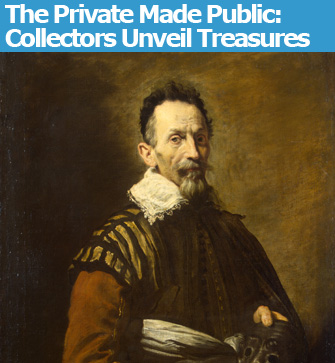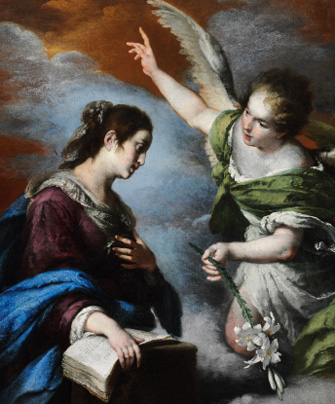 |
|
Detail of Domenico Fetti’s “Portrait of an Actor” (1620-23). © Hermitage Museum. Photo: Vladimir Terebenin, Leonard Kheifets, Yuri Molodkovets |
The Pinacothèque de Paris, flush with the success of crowd-magnet exhibitions like the continuing “Gold of the Incas: Origins and Mysteries,” now …
 |
|
Detail of Domenico Fetti’s “Portrait of an Actor” (1620-23). © Hermitage Museum. Photo: Vladimir Terebenin, Leonard Kheifets, Yuri Molodkovets |
The Pinacothèque de Paris, flush with the success of crowd-magnet exhibitions like the continuing “Gold of the Incas: Origins and Mysteries,” now has a second, roomier gallery space down the street, where it houses its new “permanent collection” consisting of works on long-term loan from private collectors.
To celebrate the birth of this “new museum,” the Pinacothèque has mounted exhibitions showing how two other museums were born and evolved: “The Hermitage, Birth of the Imperial Museum,” subtitled “The Romanovs: Tsars and Art Collectors, and “The Birth of a Museum: The Esterházys, Princes and Art Collectors.”
The visit kicks off with samplings of works collected by successive czars – Peter the Great, Catherine II, Alexander I and Nicholas I – that formed the basis of the State Hermitage Museum, founded in 1764. Peter started it all with his passion for the West and his incognito voyage through Europe in 1697. He later sent agents to buy artworks for his collection.
Among the feast-for-the eye treasures here are two marvelous Rembrandts: a handsome portrait of a bearded man wearing a beret, and a treatment of the biblical story of David and Jonathan in which David holds the weeping Jonathan close to him as they say good-bye, their sumptuous, glittering clothes brilliant against the somber background.
Another of many masterpieces on show is a sensitive portrait of a middle-aged actor with red-rimmed eyes and unkempt hair by Dominique Fetti (pictured above). The star-studded show also includes works by the likes of Van Dyck, van Ruysdael, Chardin, Poussin, Velázquez (a portrait of a man that seems uncharacteristically heavy-handed), Titian (“Christ Pantocrator”; not his best work) and many more.
The other temporary exhibition continues the parade of European masterworks with paintings from the Budapest Museum of Fine Arts by Tintoretto, Bernardo Bellotto, Raphael, Claude Lorrain, Frans Hals (a lively portrait of a man
 |
|
“Annunciation” (c. 1640) by Bernardo Strozzi. © Museum of Fine Arts, Budapest |
with an amused expression), Jan Steen, Lucas Cranach the Elder and more. One of the most captivating works is an “Annunciation” (1640) by Bernardo Strozzi (pictured above).
Forming a parenthesis between the two temporary exhibitions is the new permanent collection brought together by the Pinacothèque’s director, Marc Restellini. In the wall text introducing this collection, which he refers to as a “cabinet of curiosities,” Restellini seems to be taking a position against curated exhibitions (an unusual viewpoint for an art historian who has presented many carefully curated shows) and in favor of private collections, which he notes have provided the basis for most museums. While this may be true, museums do not just hang (or even accept) whatever collectors give them; they bring in curators to make decisions about what works to show and what context to show them in so that the public can learn something about what they are looking at.
Restellini has, of course, made curatorial decisions in hanging this collection, although he has ignored schools of art and chronology and has thrown Rembrandt, Courbet, Soutine, Corot, Modigliani, Pissarro, Duchamp, Renoir, Roault and many others together in a mash-up of artistic styles and periods he likes to call “transversality,” which he believes “brings the works to life and “creates a dialogue” between them.
There is nothing wrong with this approach when it is done thoughtfully, as it is here. And who can complain about seeing so many great paintings, most of which would otherwise be stored in bank vaults and rarely, if ever, seen by the public. Still, I left this show wishing I had learned more than the fact that the rich and noble sometimes have very good taste, as I would have in a curated show that was more than a “cabinet of curiosities.”
Pinacothèque de Paris: 28, place de la Madeleine, 75008 Paris. Métro: Madeleine. Tel.: 01 42 68 02 01. Open daily 10:30 a.m.-6 p.m. (until 9 p.m. on Wednesday; 2 p.m.-6 p.m. on May 1 and July 14). Admission: €10. Through September 15. www.pinacotheque.com
Support Paris Update by ordering books from Paris Update’s Amazon store at no extra cost. Click on your preferred Amazon location: U.K., France, U.S.
Reader Reaction: Click here to respond to this article (your response may be published on this page and is subject to editing).
More reviews of Paris art shows.
© 2011 Paris Update
